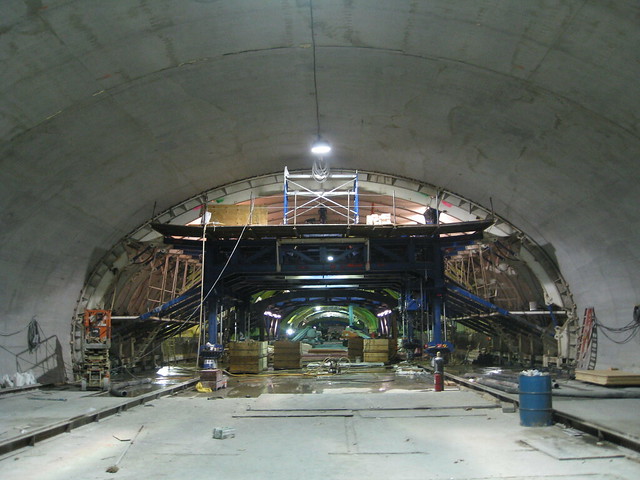End of the week. You know what that means. As always, these come to me from New York City Transit and are subject to change without notice. Listen to on-board announcements and check signs at your local station for the latest. Subway Weekender has the map.

From 11:30 p.m. Friday, April 15 to 5 a.m. Monday, April 18, 1 service is suspended between 242nd Street and 168th Street due to Dyckman Street station and structural rehabilitation, canopy and platform edge work between 242nd Street and 181st Street. A trains, free shuttle buses and the M3 bus provide alternate service. Free shuttle buses run in two sections making 1 line stops:
- On Broadway, between 242nd Street and the 207th Street A station and
- On St. Nicholas Avenue, between 168th Street and 191st Street.

From 11:30 p.m. Friday, April 15 to 5 a.m. Monday, April 18, free shuttle buses replace 2 trains between 241st Street and East 180th Street due to track, signal and switch work north of East 180th Street.

From 12:01 a.m. to 6:30 a.m., Saturday, April 16 and Sunday, April 17 and from 12:01 a.m. to 5 a.m. Monday, April 18, Brooklyn-bound 4 trains skip 33rd, 28th, and 23rd Streets, Astor Place, Bleecker, Spring and Canal Streets due to work on the gap filler at 14th Street-Union Square and construction on the Broadway/Lafayette-to-Bleecker Street transfer connection.

From 6 a.m. to 11:30 p.m. Saturday, April 16 and from 8 a.m. to 11:30 p.m. Sunday, April 17, 5 trains run every 20 minutes between 149th Street-Grand Concourse and Bowling Green due to work on the gap filler at 14th Street-Union Square and construction on the Broadway/Lafayette-to-Bleecker Street transfer connection

From 12:01 a.m. Saturday, April 16 and 5 a.m. Monday, April 18, there is no 5 service between East 180th Street and 149th Street-Grand Concourse due to track, signal and switch work north of East 180th Street. Customers should take the 2 instead. Note: During this time shuttle trains run every 30 minutes between Dyre Avenue and East 180th Street.

From 12:01 a.m. Saturday, April 16 to 5 a.m. Monday, April 18, Bronx-bound 6 trains skip Whitlock Avenue and Morrison Avenue-Soundview due to station rehabilitation at Elder Avenue and St. Lawrence Avenue.

From 12:01 a.m. Saturday, April 16 to 5 a.m. Monday, April 18, downtown 6 trains skip 33rd, 28th and 23rd Streets, Astor Place, Bleecker, Spring and Canal Streets due to work on the gap filler at 14th Street-Union Square and construction on the Broadway/Lafayette-to-Bleecker Street transfer connection.

From 12:01 a.m. Saturday, April 16 to 5 a.m. Monday, April 18, downtown A trains skip 50th Street, 23rd Street and Spring Street due to track work north of Canal Street.

From 6:30 a.m. to midnight, Saturday, April 16 and Sunday, April 17, downtown C trains skip 50th, 23rd, and Spring Streets due to track work north of Canal Street.

From 12:01 a.m. Saturday, April 16 to 5 a.m. Monday, April 18, Manhattan-bound D trains run on the N Line from Coney Island-Stillwell Avenue to 36th Street due to structural repair and station rehabilitations between 71st Street and Bay 50th Street and ADA work at Bay Parkway. There are no Manhatttan-bound D trains at stations from Bay 50th Street to 9th Avenue.

From 12:01 a.m. Saturday, April 16 to 5 a.m. Monday, April 18, Brooklyn-bound D trains run local in Manhattan from 34th Street to West 4th Street due to platform edge work at 34th Street and substation rehabilitation.

From 12:01 a.m. Saturday, April 16 to 5 a.m. Monday, April 18, downtown E trains skip 23rd Street and Spring Street due to track work north of Canal Street.

From 12:01 a.m. Saturday, April 16 to 5 a.m. Monday, April 18, E trains run local between Queens Plaza and Roosevelt Avenue in both directions due to cable replacement.

From 11:30 p.m. Friday, April 15 to 5 a.m., Monday, April 18, Q service is suspended between 57th Street-7th Avenue and Prospect Park due to tunnel inspection, structural repair, track and switch north of Atlantic Avenue. For service between 57th Street-7th Avenue and Atlantic Ave-Pacific Street, customers may take the N or R instead. Free shuttle buses are available between Atlantic Avenue and Prospect Park.

From 5 a.m. to midnight, Saturday, April 16 and Sunday, April 17, R trains are rerouted to the F line between Queens and Manhattan. Trains will make R stops between Forest Hills-71st Avenue and 36th Street in Queens, then F stops between 21st Street-Queensbridge and Lexington Avenue/63rd Street, then resume on the R line at 57th Street-7th Avenue. For service to and from Queens Plaza, Lexington Avenue/59th Street and 5th Avenue/59th Street, customers may use the E, F, 4 or 6 instead.



 By allowing motorists to ride for free across a select group of bridge is costing the city nearly $1 billion in annual revenues, the city’s Independent Budget Office said recently. The IBO has released its
By allowing motorists to ride for free across a select group of bridge is costing the city nearly $1 billion in annual revenues, the city’s Independent Budget Office said recently. The IBO has released its